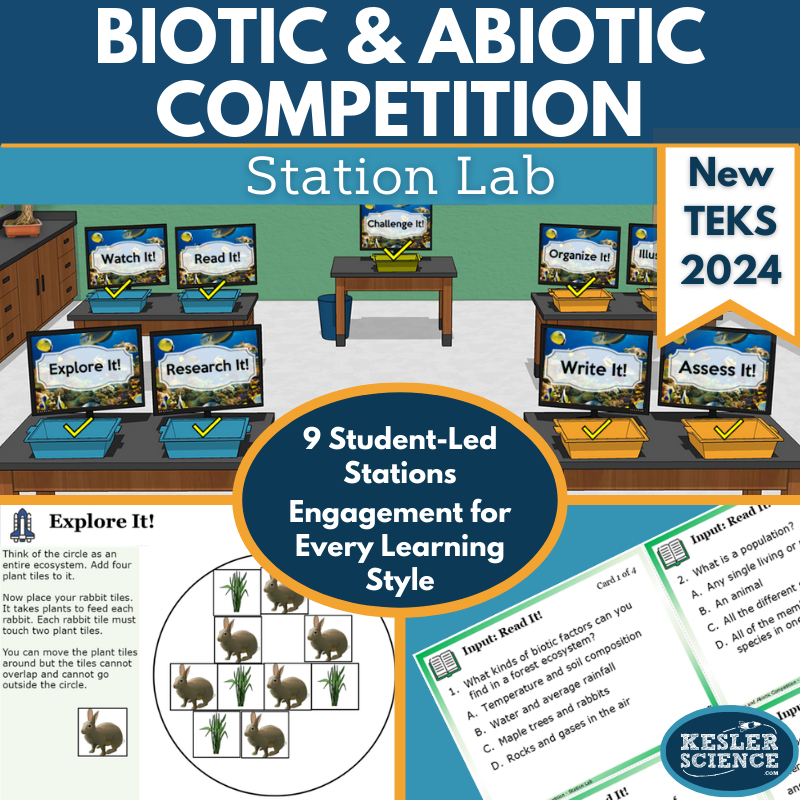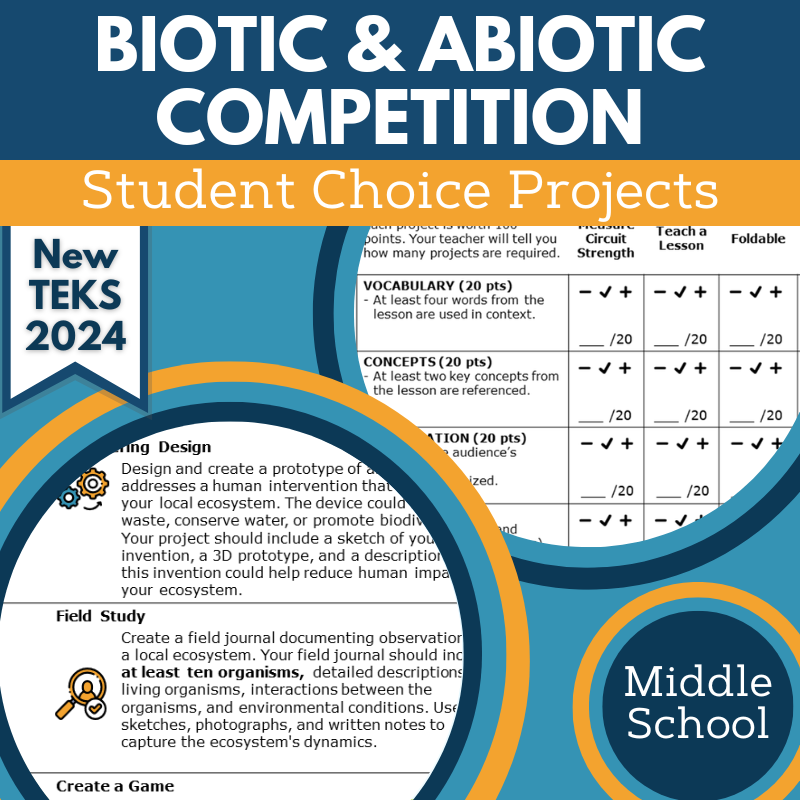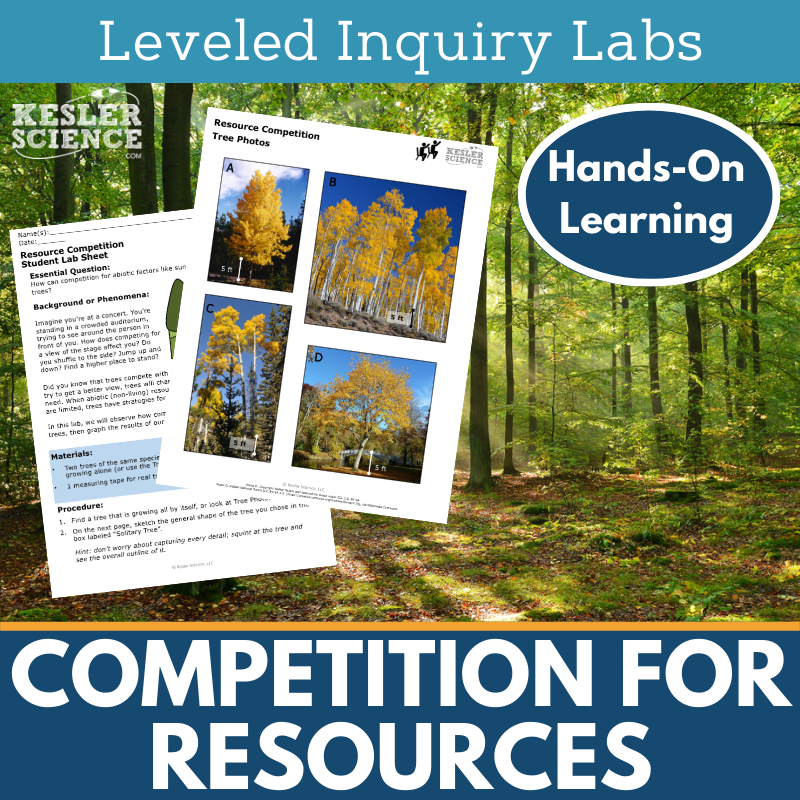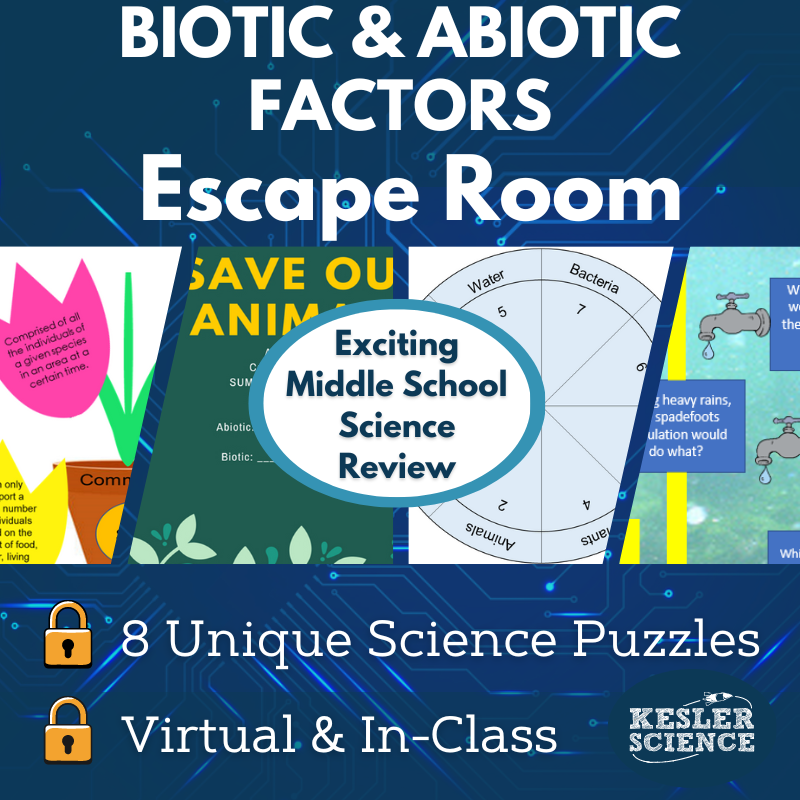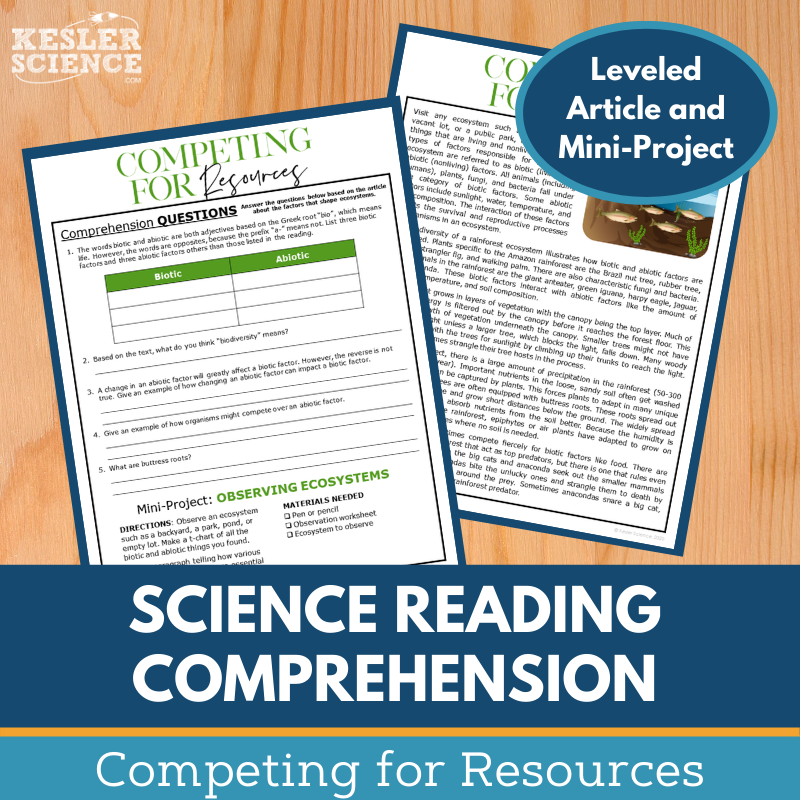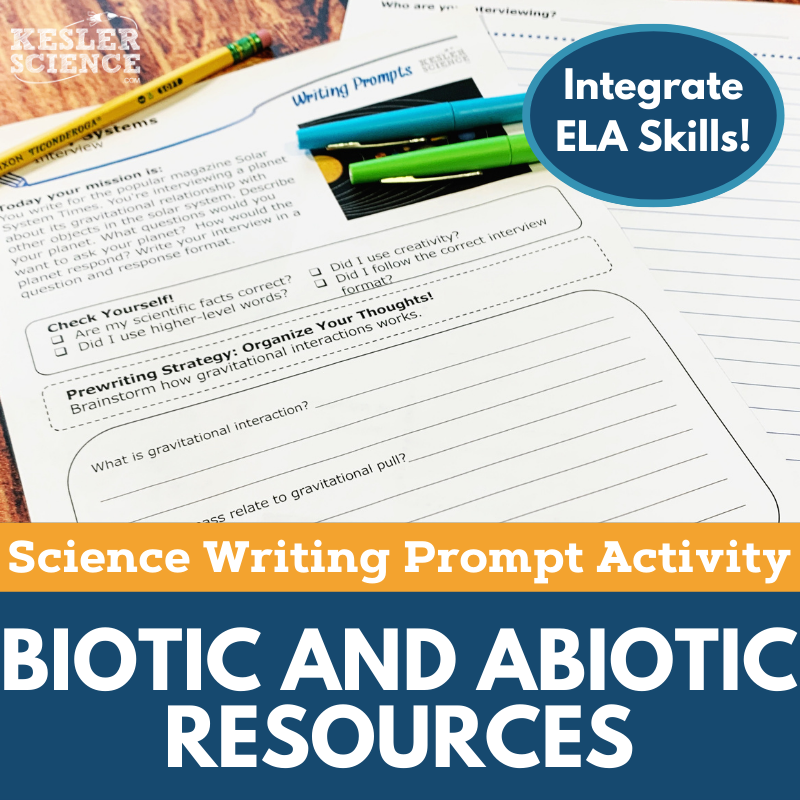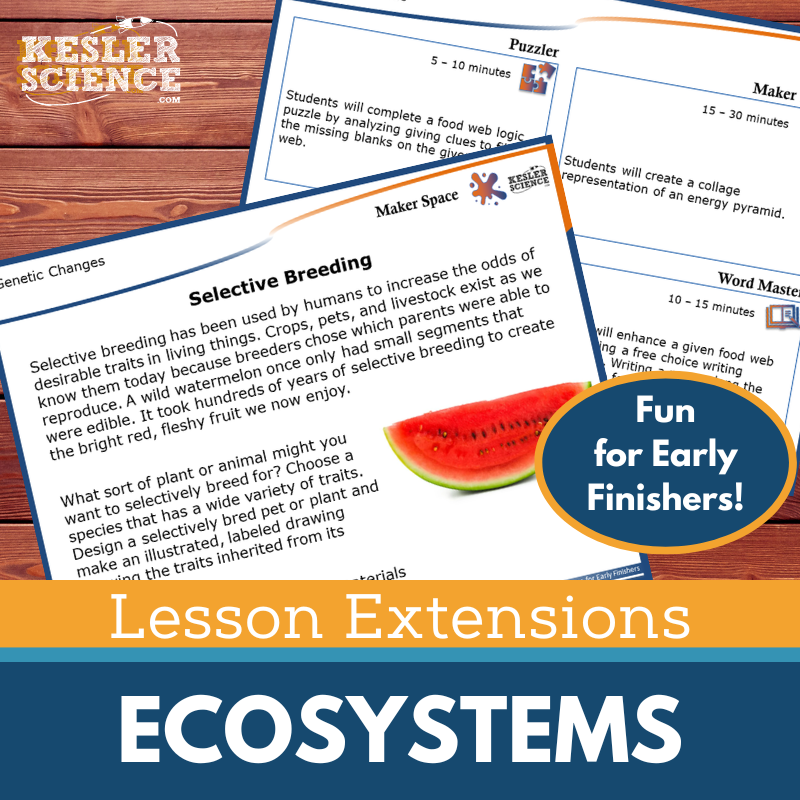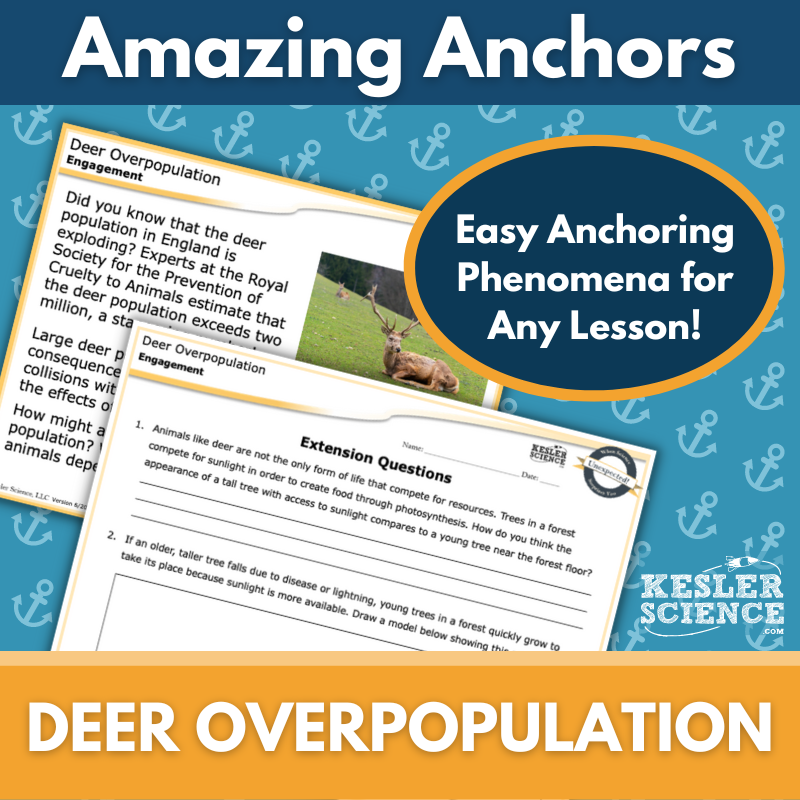Biotic & Abiotic Competition Activities for Middle School Science
Explore how organisms and populations depend on and compete for biotic and abiotic factors like food, light, water, temperature, and soil composition with this engaging middle school lesson. The resources below will give students a comprehensive understanding of biotic and abiotic competition. All of the following materials are also included in the Kesler Science Membership.
The Kesler Science Biotic & Abiotic Competition 5E Lesson is a comprehensive middle school unit exploring how organisms and populations depend on and compete for biotic and abiotic factors like food, light, water, temperature, and soil composition. This engaging, low-prep lesson includes presentations, worksheets, choice projects, and assessments, all fully editable and aligned with TEKS 6.12A.
Following the 5E Model, the lesson begins with engaging activities and word wall cards in English and Spanish. The hands-on, student-led station lab offers multimodal exploration through experiments, readings, videos, and research tasks, with differentiated input and output stations for all learners. Editable PowerPoints, interactive notebooks, and note-taking templates enhance the explanation phase. Students extend their learning through choice projects, while evaluation includes STAAR 2.0-aligned assessments and review activities.
With digital and printable options, Spanish translations, and flexible learning formats, this lesson supports in-class and virtual instruction while fostering student success through inquiry-based learning.
The Kesler Science Biotic & Abiotic Competition 5E Lesson is a comprehensive middle school unit exploring how organisms and populations depend on and compete for biotic and abiotic factors like food, light, water, temperature, and soil composition. This engaging, low-prep lesson includes presentations, worksheets, choice projects, and assessments, all fully editable and aligned with TEKS 6.12A.
Following the 5E Model, the lesson begins with engaging activities and word wall cards in English and Spanish. The hands-on, student-led station lab offers multimodal exploration through experiments, readings, videos, and research tasks, with differentiated input and output stations for all learners. Editable PowerPoints, interactive notebooks, and note-taking templates enhance the explanation phase. Students extend their learning through choice projects, while evaluation includes STAAR 2.0-aligned assessments and review activities.
With digital and printable options, Spanish translations, and flexible learning formats, this lesson supports in-class and virtual instruction while fostering student success through inquiry-based learning.
Engage your students with this student-led station lab aligned to the 2021 TEKS standard 6.12A. Designed for in-class or virtual learning, this life science lesson explores how organisms and populations depend on and compete for biotic factors like food and abiotic factors such as light, water, temperature, and soil composition.
Students direct their learning through nine differentiated stations that include hands-on activities, videos, readings, research, and interactive tasks. They demonstrate understanding by organizing information, illustrating models, writing responses, and completing assessments. A bonus challenge station offers extension activities, and English and Spanish reading passages support differentiated learning.
This low-prep, high-engagement resource promotes active learning and critical thinking.
Engage your students with this student-led station lab aligned to the 2021 TEKS standard 6.12A. Designed for in-class or virtual learning, this life science lesson explores how organisms and populations depend on and compete for biotic factors like food and abiotic factors such as light, water, temperature, and soil composition.
Students direct their learning through nine differentiated stations that include hands-on activities, videos, readings, research, and interactive tasks. They demonstrate understanding by organizing information, illustrating models, writing responses, and completing assessments. A bonus challenge station offers extension activities, and English and Spanish reading passages support differentiated learning.
This low-prep, high-engagement resource promotes active learning and critical thinking.
The Biotic & Abiotic Competition Student Choice Projects align with TEKS 6.12A, offering middle school students the flexibility to choose a project that suits their preferred output style. A project page outlines six student-led options and a “design your own” project, with an editable rubric for assessments by teachers, peers, or the students themselves. This resource is also part of the Biotic & Abiotic Competition Complete Lesson for TEKS 6.12A.
The projects are flexible, with differentiated options for students who need remediation or challenge. Teachers can adjust the rubric to meet grading needs. These multimodal projects allow students to creatively demonstrate their understanding of biotic and abiotic factors.
Standard classroom supplies like paper, markers, and scissors are typically needed, and many projects can be completed digitally.
The Biotic & Abiotic Competition Student Choice Projects align with TEKS 6.12A, offering middle school students the flexibility to choose a project that suits their preferred output style. A project page outlines six student-led options and a “design your own” project, with an editable rubric for assessments by teachers, peers, or the students themselves. This resource is also part of the Biotic & Abiotic Competition Complete Lesson for TEKS 6.12A.
The projects are flexible, with differentiated options for students who need remediation or challenge. Teachers can adjust the rubric to meet grading needs. These multimodal projects allow students to creatively demonstrate their understanding of biotic and abiotic factors.
Standard classroom supplies like paper, markers, and scissors are typically needed, and many projects can be completed digitally.
In this lab, students will explore how trees compete for sunlight, examining both biotic and abiotic factors in their environment. They can either observe trees in their natural habitat or use photos of trees to identify patterns of growth influenced by competition. The lab includes three differentiated versions to cater to different learning needs: a guided version for on-level students, a more structured version for students needing modifications, and an independent version for advanced learners.
The resource provides teacher prep materials, answer keys, and reflection questions that encourage students to think critically and develop claim, evidence, and reasoning statements. The lab aligns with TEKS, helping students understand how organisms and populations compete for essential resources like food, light, water, and soil. Materials for the lab include tree specimens or photos, a measuring tape or ruler, and internet access for the independent version.
In this lab, students will explore how trees compete for sunlight, examining both biotic and abiotic factors in their environment. They can either observe trees in their natural habitat or use photos of trees to identify patterns of growth influenced by competition. The lab includes three differentiated versions to cater to different learning needs: a guided version for on-level students, a more structured version for students needing modifications, and an independent version for advanced learners.
The resource provides teacher prep materials, answer keys, and reflection questions that encourage students to think critically and develop claim, evidence, and reasoning statements. The lab aligns with TEKS, helping students understand how organisms and populations compete for essential resources like food, light, water, and soil. Materials for the lab include tree specimens or photos, a measuring tape or ruler, and internet access for the independent version.
The Biotic and Abiotic Factors Escape Room is an engaging activity designed to help students explore biotic and abiotic components of ecosystems and how organisms depend on and compete for these factors. TEKS aligned, the escape room challenges students to understand interactions between organisms and their environments, making complex scientific concepts more accessible and enjoyable. The immersive format encourages students to actively apply their knowledge while solving puzzles related to ecosystem dynamics.
Teachers have full flexibility over the activity, with eight independent puzzles to choose from and the option to select the order and number of puzzles to suit class time. The escape room can be set up using simple materials like manila envelopes or a more authentic lock-and-box setup, requiring locks, a lockout hasp, and a storage box. In both cases, additional materials such as invisible ink pens, brads, and red saran wrap are included for added interactivity.
This resource includes comprehensive teacher directions, answer keys, an editable version for customizing puzzles, and a digital answer sheet for use with Google Classrooms. For digital learning, a Single Student Digital Version is available via PowerPoint or Google Slides, while a print version can be shared with students to complete at home. The activity also features a video challenge, over 50 prize ideas, reward templates, and 30 unique photo signs to make the experience memorable for students.
The Biotic and Abiotic Factors Escape Room is an engaging activity designed to help students explore biotic and abiotic components of ecosystems and how organisms depend on and compete for these factors. TEKS aligned, the escape room challenges students to understand interactions between organisms and their environments, making complex scientific concepts more accessible and enjoyable. The immersive format encourages students to actively apply their knowledge while solving puzzles related to ecosystem dynamics.
Teachers have full flexibility over the activity, with eight independent puzzles to choose from and the option to select the order and number of puzzles to suit class time. The escape room can be set up using simple materials like manila envelopes or a more authentic lock-and-box setup, requiring locks, a lockout hasp, and a storage box. In both cases, additional materials such as invisible ink pens, brads, and red saran wrap are included for added interactivity.
This resource includes comprehensive teacher directions, answer keys, an editable version for customizing puzzles, and a digital answer sheet for use with Google Classrooms. For digital learning, a Single Student Digital Version is available via PowerPoint or Google Slides, while a print version can be shared with students to complete at home. The activity also features a video challenge, over 50 prize ideas, reward templates, and 30 unique photo signs to make the experience memorable for students.
In this lesson, students explore competition for resources in ecosystems by reading a nonfiction article about biotic and abiotic factors in the Amazon rainforest. They complete comprehension questions and observe a local ecosystem before writing a paragraph about their findings.
The resource is designed for middle school students and includes two leveled articles (Lexile levels 1100-1300), corresponding questions, and a hands-on mini-project. The activity also features a Cornell notes template and colorful graphics that can be printed in grayscale.
This resource is ideal for in-person or virtual learning environments, compatible with Google Classroom, MS Teams, Schoology, and Canvas. It’s suitable for a range of classroom situations, including absences, extra credit, sub plans, and whole-class instruction, while helping to build science literacy and reading comprehension.
In this lesson, students explore competition for resources in ecosystems by reading a nonfiction article about biotic and abiotic factors in the Amazon rainforest. They complete comprehension questions and observe a local ecosystem before writing a paragraph about their findings.
The resource is designed for middle school students and includes two leveled articles (Lexile levels 1100-1300), corresponding questions, and a hands-on mini-project. The activity also features a Cornell notes template and colorful graphics that can be printed in grayscale.
This resource is ideal for in-person or virtual learning environments, compatible with Google Classroom, MS Teams, Schoology, and Canvas. It’s suitable for a range of classroom situations, including absences, extra credit, sub plans, and whole-class instruction, while helping to build science literacy and reading comprehension.
The Biotic and Abiotic Resources Science Writing Prompt Activity engages middle school students in a creative exercise to reinforce their understanding of life science concepts. TEKS aligned, it helps students explore how organisms depend on and compete for biotic factors like food and abiotic factors such as light, water, and soil composition. The activity is structured around a "day in the life" story, making it both fun and engaging while enhancing science reasoning.
This resource includes teacher directions, rubrics, projection versions for digital classrooms, full-sized and half-sheet handouts, and a digital interactive version compatible with Google Slides. The activity can be used in various ways, including as a cross-curricular project, formative assessment, student choice activity, or differentiation exercise. It’s also perfect for extra credit, makeup work, or early finishers. Ideal for both in-person and remote learners, it’s an engaging tool to deepen science literacy.
The Biotic and Abiotic Resources Science Writing Prompt Activity engages middle school students in a creative exercise to reinforce their understanding of life science concepts. TEKS aligned, it helps students explore how organisms depend on and compete for biotic factors like food and abiotic factors such as light, water, and soil composition. The activity is structured around a "day in the life" story, making it both fun and engaging while enhancing science reasoning.
This resource includes teacher directions, rubrics, projection versions for digital classrooms, full-sized and half-sheet handouts, and a digital interactive version compatible with Google Slides. The activity can be used in various ways, including as a cross-curricular project, formative assessment, student choice activity, or differentiation exercise. It’s also perfect for extra credit, makeup work, or early finishers. Ideal for both in-person and remote learners, it’s an engaging tool to deepen science literacy.
This set of WIKI Tickets© provides engaging formative assessments for 6th-8th grade science topics, offering flexible options to check student understanding. The Ecosystems Set includes 20 assessments, each available in five formats: a full-screen projection version, three print handouts (full, split, and quarter-page sizes), and an interactive version for digital use via PowerPoint or Google Slides.
Aligned with NGSS and TEKS standards, the assessments cover a wide range of topics, such as biodiversity, ecological succession, food chains, human impact on oceans, and natural selection. Each topic has at least one assessment, with some offering multiple tickets. A bonus table of contents is included for easy reference.
These versatile assessments are suitable for both in-person and virtual learning environments. They can be used as exit tickets, bellringers, or quick checks for student understanding. Whether projecting on-screen, printing handouts, or using digital formats, WIKI Tickets© are a ready-to-use resource for any classroom setup.
This set of WIKI Tickets© provides engaging formative assessments for 6th-8th grade science topics, offering flexible options to check student understanding. The Ecosystems Set includes 20 assessments, each available in five formats: a full-screen projection version, three print handouts (full, split, and quarter-page sizes), and an interactive version for digital use via PowerPoint or Google Slides.
Aligned with NGSS and TEKS standards, the assessments cover a wide range of topics, such as biodiversity, ecological succession, food chains, human impact on oceans, and natural selection. Each topic has at least one assessment, with some offering multiple tickets. A bonus table of contents is included for easy reference.
These versatile assessments are suitable for both in-person and virtual learning environments. They can be used as exit tickets, bellringers, or quick checks for student understanding. Whether projecting on-screen, printing handouts, or using digital formats, WIKI Tickets© are a ready-to-use resource for any classroom setup.
Lesson Extensions provide engaging, student-choice activities that challenge fast finishers and deepen understanding of ecosystems. These activities are perfect for lesson wrap-ups, filling gaps during testing, and keeping students engaged with fun yet rigorous learning.
Each extension includes four components: Puzzler for problem-solving, Maker Space for hands-on STEAM activities, Tech Connection for digital demonstrations, and Word Master for creative writing. Teacher directions, answer keys, and both print and projection versions are included for easy classroom use.
Aligned with NGSS and TEKS standards, the extensions cover a wide range of ecosystem topics, including biodiversity, biomes, food webs, human impact, and more. They provide a flexible way to enrich independent learners while reinforcing core science concepts.
Lesson Extensions provide engaging, student-choice activities that challenge fast finishers and deepen understanding of ecosystems. These activities are perfect for lesson wrap-ups, filling gaps during testing, and keeping students engaged with fun yet rigorous learning.
Each extension includes four components: Puzzler for problem-solving, Maker Space for hands-on STEAM activities, Tech Connection for digital demonstrations, and Word Master for creative writing. Teacher directions, answer keys, and both print and projection versions are included for easy classroom use.
Aligned with NGSS and TEKS standards, the extensions cover a wide range of ecosystem topics, including biodiversity, biomes, food webs, human impact, and more. They provide a flexible way to enrich independent learners while reinforcing core science concepts.
This Amazing Anchors lesson introduces competition in ecosystems using a two-part activity. The first part is an introductory reading on deer overpopulation, followed by comprehension and extension questions to prepare students for further learning. The second part explains the science behind overpopulation and competition in ecosystems, with additional questions for reinforcement.
Included in this resource are teacher directions, answer keys, and extra resources. The lesson is available in both digital and print formats, including a projection version with full-page slides, and editable PPTs for LMS platforms. There are also paper handouts for students.
Aligned with TEKS, this lesson works well to introduce or follow-up on lessons about ecosystem competition. The lesson is differentiated with a modified version that includes sentence starters for student support. Designed as a supplement to your lesson, these readings and questions are ideal for both in-person and virtual classrooms.
This Amazing Anchors lesson introduces competition in ecosystems using a two-part activity. The first part is an introductory reading on deer overpopulation, followed by comprehension and extension questions to prepare students for further learning. The second part explains the science behind overpopulation and competition in ecosystems, with additional questions for reinforcement.
Included in this resource are teacher directions, answer keys, and extra resources. The lesson is available in both digital and print formats, including a projection version with full-page slides, and editable PPTs for LMS platforms. There are also paper handouts for students.
Aligned with TEKS, this lesson works well to introduce or follow-up on lessons about ecosystem competition. The lesson is differentiated with a modified version that includes sentence starters for student support. Designed as a supplement to your lesson, these readings and questions are ideal for both in-person and virtual classrooms.
Year-Round Resources
These year-round activities will increase your students' understanding of many middle school science topics. All of these activities are also included in the Kesler Science Membership.
Visual Data & Graphing
You're not alone if your students struggle with understanding graphs, charts, and tables. It's a skill that takes an enormous amount of practice. This resource will help students build a strong foundation in analyzing data and creating their own data visualizations.
Bell Ringers and Warm-Ups
These middle school science bell ringers are an excellent way to engage your students as soon as they walk into your classroom. This comprehensive FULL YEAR resource includes everything you need to start off each science class with an interesting warm-up activity.
Review Board Games
Each game board has been carefully designed to keep students engaged. There are 10 different action spaces on each board and dozens of question cards. All of the actions are related to science concepts and keep the students motivated throughout the game.
Each game is ready to play. Simply print out the board and the cards and let the students enjoy reviewing nine different units.
Essential Questions and Standards
Below are the essential questions and standards associated with the lessons and activities included in the atoms unit. This topic is only one of more than 100 middle school science topics included in the Kesler Science Membership.
-
What distinguishes a biotic factor, such as food, from an abiotic factor, such as the availability of light and water, range of temperatures, or soil composition in an ecosystem?
-
How can we investigate how organisms and populations in an ecosystem depend on and may compete for biotic and abiotic factors?
-
TEKS Science - 6.12A Biotic & Abiotic Competition
Kesler Science Membership
Imagine never having to search for another middle school science lesson again. The membership gives you access to ALL of the Kesler Science products in one place (Yes, including everything above).
Say goodbye to long hours of lesson prep.



